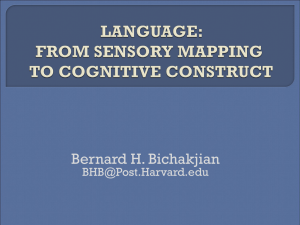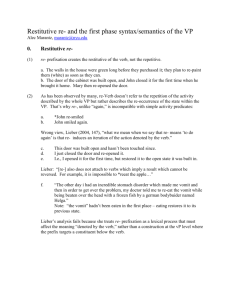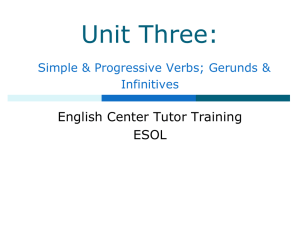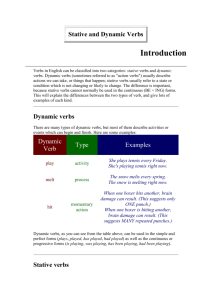KoreaHO
advertisement
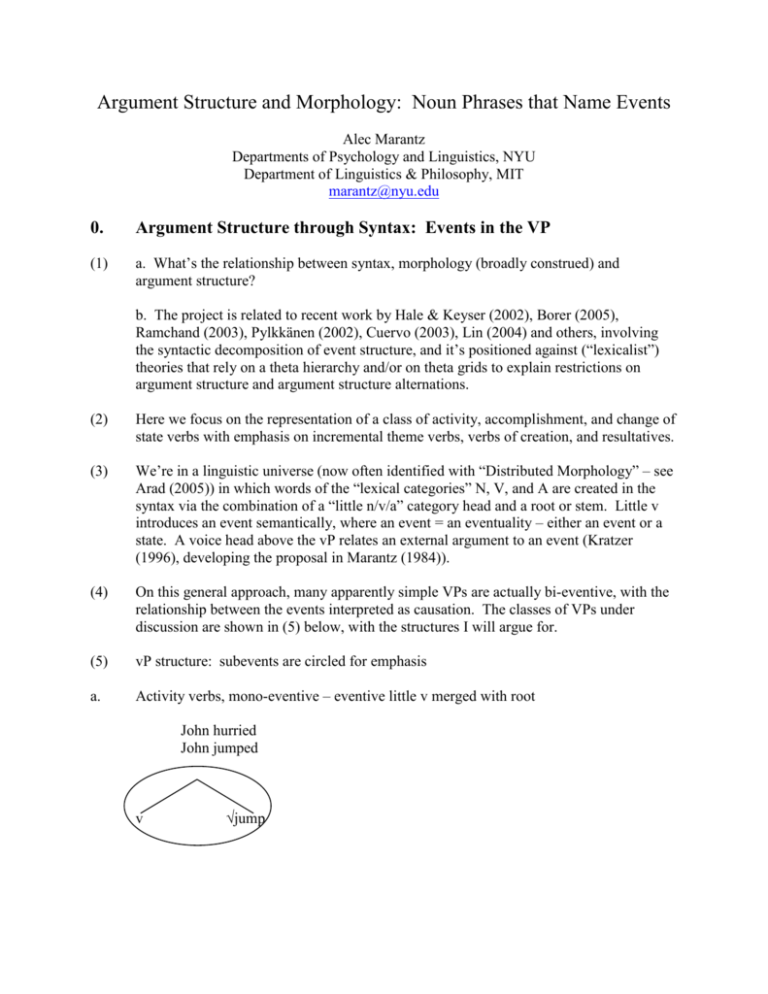
Argument Structure and Morphology: Noun Phrases that Name Events Alec Marantz Departments of Psychology and Linguistics, NYU Department of Linguistics & Philosophy, MIT marantz@nyu.edu 0. Argument Structure through Syntax: Events in the VP (1) a. What’s the relationship between syntax, morphology (broadly construed) and argument structure? b. The project is related to recent work by Hale & Keyser (2002), Borer (2005), Ramchand (2003), Pylkkänen (2002), Cuervo (2003), Lin (2004) and others, involving the syntactic decomposition of event structure, and it’s positioned against (“lexicalist”) theories that rely on a theta hierarchy and/or on theta grids to explain restrictions on argument structure and argument structure alternations. (2) Here we focus on the representation of a class of activity, accomplishment, and change of state verbs with emphasis on incremental theme verbs, verbs of creation, and resultatives. (3) We’re in a linguistic universe (now often identified with “Distributed Morphology” – see Arad (2005)) in which words of the “lexical categories” N, V, and A are created in the syntax via the combination of a “little n/v/a” category head and a root or stem. Little v introduces an event semantically, where an event = an eventuality – either an event or a state. A voice head above the vP relates an external argument to an event (Kratzer (1996), developing the proposal in Marantz (1984)). (4) On this general approach, many apparently simple VPs are actually bi-eventive, with the relationship between the events interpreted as causation. The classes of VPs under discussion are shown in (5) below, with the structures I will argue for. (5) vP structure: subevents are circled for emphasis a. Activity verbs, mono-eventive – eventive little v merged with root John hurried John jumped v jump b. Verbs with direct objects interpreted as undergoing a change of state (incremental theme verbs, verbs of creation) These verbs are built from (5a) by merging another subevent with the activity subevent; the causative interpretation of relation between the subevents comes from the structure without a mediating head. bake a cake build a house clean the apple v v the cake (creation) (creation) (incremental theme; apple “measures” the cleaning) DP coerced into a change of state event involving the cake as “measure” of the event bake i. Crucially, the meaning of the direct object is a resulting state: In the case of a verb of creation, like “bake,” this is the state of being an example of the type of the direct object – being a “cake” in this case. As sister to an activity little v, the state is interpreted as the result of an activity; ingredients are caused to go from not-cake to cake, with cake as the final result. For an incremental theme verb such as “clean,” in “clean the apple,” the resultant state is “cleaner apple than a previous state of the apple”; as sister to an activity v, this state is interpreted as the result of an activity; the apple is caused to go from less to more clean via a cleaning activity. ii. NOTE: activity verbs in (5a) can become incremental theme verbs as in (5b) via addition of a cognate object: John danced (a dance/a waltz) John sang (a song/an aria) The meaning of “John baked a cake” and “John danced a waltz” are thus parallel (the waltz is created via dancing and thus transitions from not-waltz to waltz), and the following additional parallelisms are not surprising: John baked me a nice cake/ John danced me a nice dance “Someone who will sing me to sleep. Dance me a waltz when i wake up. Longwalks at 5pm, hotchoco at 5am.” "Tell Me a Story, Dance Me a Dance" John re-baked the cake/ re-danced the dance the carefully baked cake/ nicely danced dance 2 c. The verb root can name a state that is caused by the activity introduced by the little v head. Here the root is the head of a lower, caused, event. These verbs easily allow transitive/anticausative alternations depending on whether or not the causing event is an agentive activity open the door spin the wheel (eventive root) flatten the pancake (-en realizes little v as event head) freeze the ice cream v the door d. open stative eventuality, interpreted as caused by an eventuality introduced by the little v Small clause structures with a complex inner event (built from (5a) by merging a small clause event as complement to v) send [the book to John] put [the book on the table] drink [the teapot dry] shake [the machine to pieces] paint [the wall red] stative eventuality, interpreted as change v v put the book of state caused by activity modified by “put” on the table NOTE: It is now an open question whether the embedded event for these small clause causative constructions should include the direct object (=the small clause subject). e. “Low applicative” double object constructions (type of small clause), with transfer of possession meaning (see Pylkkänen (2000), here consistent with a line of work from Kayne through Harley), created from (5a) by merging possessive small clause built with an applicative head. give [John a book] hand [John an apple] 3 v v hand John appl f. an apple “High applicative” (Pylkkänen (2000), here following a line of work from Marantz (1993)) double object constructions with benefactive readings built from (5b) with an applicative head that relates an event to an individual bake John a cake open John a beer make John a sandwich v v bake John appl (6) a cake Preview: The data concerning stative passives and re- prefixation discussed in this talk will provide strong evidence for specific aspects of the above structures. In particular: a. the treatment in (5b) of direct objects as resultant states b. the uniform treatment of “thematic” (paint the wall red) and “non-thematic” (drink the teapot dry) resultative constructions as involving small clauses (following Kratzer and a host of linguists before her) c. the contrast between transfer of possession low applicative constructions (5e), which pattern here with resultative small clauses, and benefactive high applicative constructions (5f), which pattern with verbs of creation (i.e., with the constructions from which they are derived via the applicative head) 4 (7) The kind of distributional data under discussion: a. They repainted the walls. b. The walls remained painted throughout the centuries. c. *They re-put the book on the table. d. *The book seemed put on the table. e. *They re-gave John the award. f. *John seemed given the award. (8) Here we will derive generalizations about the distribution of the stative passive and of refrom selectional and (semantic) compositional properties of the functional heads realized as the stative passive and re-. The approach is set in contrast with: a. b. Thematic approaches, where explanations are based on generalizations over theta grids or similar lexical argument structures Templatic approaches, where generalizations are based on complementary distributions predicted by phrase-structure type restrictions (includes Hale & Keyser, Keyser & Roeper, Ramchand and a long tradition) 1. “Adjectival” passives and the Sole Complement Generalization (9) We take off from Levin & Rappaport (1986), which in turn relies on the theta-based theory of argument structure developed in Marantz (1984). (10) Diagnostics of stative (“adjectival”) passives (note: diagnostics based on an initial classification that has “given a book” as exclusively a verbal, eventive passive) (11) a. complement to seem and remain John seems/remained angry/blessed/pissed off *John remained given a book. *The teapot remained drunk dry. b. input to un- prefixation unexamined, unprepared, unloved *an ungiven person, *an undrunk dry teapot Restrictions on stative passives a. must take thematic object i. It seemed *(to have been) uttered that John should leave. ii. Tabs seemed *(to have been) kept on Jane Fonda. iii. The teapot seemed *(to have been) drunk dry. 5 b. Sole Complement Generalization: only arguments that can stand alone with the verb in the active VP can be the subject of a stative passive i. rules out first object of double object constructions ii. rules out some verbs of spray/load type iii. rules out some verbs of change of location (12) Sole Complement Generalization (judgments from Levin and Rappaport) a. b. c. d. e. f. hand John a book/slip the spy message hand a book to John/slip a message to the spy *hand John, *hand a message/*slip the spy, *slip a message *the unhanded person/book/ *the unslipped spy/message *The book seemed/remained handed to John. *The message seemed/remained slipped to the spy. g. h. i. cram food into the freezer, cram the freezer with food *They crammed food yesterday/ They crammed the freezer ??The food remained crammed in the freezer/ The freezer remained crammed with food. pile the books on the shelf/ pile the shelf with books They piled books yesterday/ *They piled the shelf The books remained piled on the shelves/ *The shelves remained piled with books. place books on the table/ put books on the table ??They placed the books yesterday/ *They put the books yesterday *the book seemed/remained placed/put on the table j. k. l. m. n. o. (13) Levin & Rappaport: Description: -en (the passive affix) creates an adjective from a verb and externalizes the designated internal argument (the one that will be either the object of a transitive or the subject of the passive or unaccusative) Analysis (claim): Restrictions on the stative passive follow from stating just the category-changing property of the suffix: it takes the perfect/passive participle and creates an adjective; “externalization” of the internal argument, the thematic restriction, and the sole complement generalization follow from nature of adjectives (they require an external argument and don’t allow certain types of complements) and from the projection principle (obligatory arguments must be expressed). 6 (14) This might works for double object constructions: adjectives don’t allow the expression of bare DP complements: a. b. *John seemed given yesterday. (bad via the projection principle; obligatory argument not expressed) *John seemed given a book yesterday. (bad because adjectives can’t “project” the obligatory second object) (15) However, this account doesn’t cover the data in (12e, f, j, l, o), all falling under the Sole Complement Generalization. (16) Syntactic theory of stative passive construction (Embick (2004) and Kratzer (2004), although there are important differences between their approaches that will not be relevant here) a. Type One, root attaching: the stative functional head attaches to a stative head (for Embick, a root) (what Kratzer calls “target state” passives) b. Type Two: the stative head attaches higher and the structure includes a causing event (so describes a completed change of state, rather than simply a state (an end state)) (=a subset of what Kratzer calls “resultant state”) (17) Proposal: Type two merges with a DP interpreted as a resultant state, i.e., lower subevent in (5b) above. (18) a. Type One (no little v) stative close Semantically, the stative head must form a predicate with a single (“external”) argument. In this case, the stative head produces an adjective whose subject will be interpreted as “closed.” b. stative Type Two (eventive, little v) DP PRO v bake 7 The reading of the sub-event expressed by a DP is the resulting state of the DP having undergone a change of state compatible with the causing event (here, the activity of “baking”) and with the nature of the DP itself. The stative head creates a reading where the DP is in the resultant state. The entire participle phrase baked in (18b), then, is a predicate describing a resultant end-state computed in the left hand sub-event and caused by the activity of “baking.” Obviously, I’ve reversed the hierarchy of sub-events in (18b) from that of an eventive vP (5b), where the activity is the main predicate and the result the subordinate predicate. Here the resultant state is the main eventuality, with the causing event serving as an adjunct. Nevertheless, the sisterhood relation between the sub-events – the structure that triggers the causative reading of the relationship – is maintained in (18b). (19) By placing the resultant state “above” the activity little v in (18b), we create an essentially unaccusative predicate; the structure leaves no place for a voice node to project an external argument. The lack of by-phrases with stative passives should follow from the absence of a voice head, but drawing this prediction is not entirely straight-forward. (20) The structure in (18b) should be similar to that for middles in English. As argued in Lekakou (2005), “Middles ascribe a disposition to the understood object.” The disposition is to reach a resultant state via the activity introduced by the little v, as in the structure in (18b) Middle: “these books sell well” middle these books v sell We’ll see that middles obey many of the same constraints as stative passives, as expected from this structure. Like statives, they resist a by-phrase expression of an agent of the activity subevent. (21) Embick on Type One: Root-attaching affixes can have stem-dependent allomorphs a. The door seems closed/open/*close/??opened b. hung jury, fallen tree, rotten fruit (apple was rotted/ *rotten by the sun) Crucially, Type One statives pattern with simple adjectives (the stative is the first category-determining head to attach to the root). 8 Table I: predictions about the distribution of stative passives vP structure stative passive? why bad/notes a. activity no b. incremental themes c. verb root as lower event d. small clause yes yes no e. low applicative no f. high applicative no no change of state sub-event to combine with Type Two Type One selection: stative takes a head that names a state or a DP coerced into resultant state but not a complex change of state event selection: lower DP isn’t an eventuality and whole applicative phrase is a small-clause selection: the stative head creates a predicate, to which the applicative cannot be merged; if the applicative merges first, it creates a phrasal constituent that is not a DP coerced into a resultant state (22) How does this analysis derive the Sole Complement Generalization? To put it differently, why should the optionality of the second complement in the examples in (12) matter for the formation of the stative passives? (23) In a vP like, “spray the wall with water,” “with water” could be part of a small clause (5d, e) structure, or it could be an adverbial phrase, modifying an event in the VP. How can we tell the difference? (24) As detailed in the next section of the talk, re- prefixation targets the inner event of a vP and won’t co-occur with small clauses. Thus re- prefixation brings out the adverbial interpretation of an apparent second complement when such an interpretation is available. a. re-spray the wall with water (the water could be used only for the second spraying, meaning that there’s a sub-event in the VP that excludes the water and that “with water” can be adverbial, modifying the subevent of change of state caused by spraying) b. repaint the wall red (the wall could have been painted blue the first time, so “red” can stand outside the event of changing state via painting and can be an adverbial modifier) 9 (25) If the second complement is optional, then, structures containing both complements are potentially ambiguous between a structure in which the second complement is the head of a small clause and a structure in which the second complement functions as an adverbial modifier of a subevent: a. b. c. paint the wall paint [the wall blue] paint [ [the wall] blue] Only the structure in c., where the second complement functions as an adverbial, might allow stative passives. (26) The structures are disambiguated by re- prefixation, since re- won’t occur with small clauses. When re- occurs with verbs with optional second complements and the second complement is present, re- has narrow scope over the event named by the first complement: a. re-paint the wall red, re- scopes over the change of state of the wall, not the becoming red b. re-stuff the refrigerator with beer, re- scopes over the change of state of the refrigerator, not the becoming “with beer,” so refrigerator may have been stuffed with food prior to being re-stuffed with beer (27) So the Sole Complement generalization follows if a. stative won’t attach to a small clause b. an obligatory second complement necessarily implies a small clause structure c. an optional second complement implies possible adverbial interpretation for the second complement d. presence of stative passive with second complement (painted blue) disambiguates the second complement to the adverbial reading, just as re- prefixation does 2. “re-“ and the Abstract clitic hypothesis (28) Restriction: re- prefixation favors unaccusative and accomplishment verbs over unergative and patient-taking transitives (Horn (1980)) a. b. c. d. (29) The stain reemerged/reappeared, The door re-opened, The ice-cream remelted I reopened the door, repainted the house, rearranged the furniture… ??I resmoked, relaughed, resang. ??I rekicked the wall, rereached the top,.. Horn’s generalization: re- requires object (transitive object or underlying object of unaccusative) 10 (30) Keyser and Roeper: although re- requires a direct object, it will not co-occur with certain additional complements, nor will it attach to transitive verbs that exhibit certain argument structure alternations. (31) Restrictions follow from the “Abstract Clitic Hypothesis” if re- either occupies or implicates a clitic position also required by other constructions. Then re- prefixation and these other constructions will be in complementary distribution (templatic, phrasestructural approach to restrictions and co-occurrences) (32) Some of Keyser and Roeper’s generalizations and some of their data are wrong. We’ll extract the insights from their paper and only explicitly point out errors when they’re important for present purposes. (33) Re- prefixation generally obeys the Sole Complement Generalization: a. *John re-handed (Bill) (a book). b. *John re-crammed the food. c. *John re-piled the shelves. d, *John re-put (the books) (on the table). (34) If the Abstract Clitic Hypothesis accounts for the Sole Complement Generalization, then we should extend the Hypothesis to the stative passives and propose that the stative passive morpheme also occupies or implicates the abstract clitic position. But in that case we would incorrectly expect that re- and the stative passive would be in complementary distribution. (Data below from a Google search.) a. Why are there so many unrepainted Scanias? b. That's the real thing.. unedited, unrecreated. c. VIA also purchased 7 more mid-train domes built for US roads, all stored unrebuilt. (35) Moreover, and more crucially, Keyser and Roeper predict that re-, like stative passives, should not co-occur with double object constructions, even benefactive double object constructions. But this prediction is false: a. Oh, and it's "not mission-critical" so they will rebuild me a computer "in a day or two." b. I went to get a mocha, iced, and they gave me a moca frappuccino... so they remade me a mocha and let me keep the frappuccino. c. He agreed that the scoop did have some flaws and remade me a new insert within a matter of days. d. When I think about the human disaster in the wake of Hurricane Katrina, there are two moments that stand out in my mind. The first is George W. Bush's press conference in Mississippi on September 2, during which he bounced uneasily from foot to foot like he couldn't wait to get out of there, looking sullen and furrowed, observing with tense jocularity that Trent Lott's house had been lost, too, and that "we" were going to rebuild him "a fantastic house" and that he, our President, was looking forward to rocking on the porch when that day came to pass. 11 (36) Proposal: re- targets the inner event of a bi-eventive structure a. Type One (low): targets the root in (5c) reopen the door re-opened all our freezing rain and sleet melted and refroze solid it rained for a few days and refroze solid (note non-thematic subject, which is possible for Type One statives and re- formations, but not for Type Two) It remained frozen outside. b. Type Two (high): targets a DP interpreted as resultant state in (5b) v v bake re- the cake Interpretation: baking caused the resultant state of being a cake, and this state was restored (so, “the cake” existed before, and baking restored this state). For incremental theme verbs like, “John re-cleaned the apple,” the interpretation is parallel: cleaning caused the resultant state of a clean apple, and this state was restored, so the apple was clean before. (37) As has been observed by many, re-Verb doesn’t refer to the repetition of the activity described by the whole VP but rather describes the restoration of the resulting state within the VP. That’s why re-, unlike “again,” is incompatible with simple activity predicates: a. b. *John re-smiled John smiled again. Wrong view in Lieber (2004, 147), “what we mean when we say that re- means ‘to do again’ is that re- induces an iteration of the action denoted by the verb.” c. d. e. This door was built open and hasn’t been touched since. I just closed the door and re-opened it. I.e., I opened it for the first time, but restored it to the open state it was built in. Lieber: “[re-] also does not attach to verbs which imply a result which cannot be reversed. For example, it is impossible to *reeat the apple…” f. “The other day i had an incredible stomach disorder which made me vomit and then in order to get over the problem, my doctor told me to re-eat the vomit while being beaten over the head with a frozen fish by a german bodybuider named Helga.” 12 Note: “the vomit” hadn’t been eaten in the first place – eating restores it to its previous state. Lieber’s analysis fails because she treats re- prefixation as a lexical process that must affect the meaning “denoted by the verb,” rather than a construction at the vP level where the prefix targets a constituent below the verb. (38) Some examples from a Google search (a,b) and informants. a. “I used the carrot cake recipe which includes instant vanilla pudding. I have just realized that I used "Cook and Serve" vanilla pudding by mistake. This cake is for a groom's cake this weekend. Do I need to rebake the cake or will it really make any difference?” (Although here the agent of the activity is the same in both the baking and the re-baking (“I”), the meaning of re-bake is compatible with different agents – the crucial sentence could be, “Do I need to ask someone to rebake the cake [i.e., cause “the cake” – another token of the same type – to come into existence via baking]…?”) b. “I want to suggest, though, that one lens through which we can reasonably view Al Quie's approach to education these past eighty years is that of a person trying to apply the doctrine of subsidiarity to that multi-tiered marble cake. Putting it differently, Al has patiently and assiduously tried to re-bake the cake with neater layers and less marbling.” (wants to cause the cake to come into existence again, only better) d. re-build the 18th century cathedral e. re-create the current situation Table II: predictions about the distribution of re- prefixation vP structure re- prefixation? why bad/notes a. activity no b. incremental themes c. verb root as lower event d. small clause yes yes no e. low applicative no f. high applicative yes no change of state sub-event to combine with Type Two Type One [unaccusatives] selection: re-takes a head that names a state or a DP coerced into a resultant state but not a complex change of state event selection: lower DP isn’t an eventuality and whole applicative phrase is a small-clause !!!!!! re-cursive! 13 (39) Keyser & Roeper: verb classes that do not allow re- are characterized by their potential to occur in the double object construction (rather than the obligatoriness of a second complement, as in the Sole Complement Generalization) a. John bought me a car. b. *John purchased me a car. c. *John rebought the car. d. John repurchased the car. False data: e. I rebought the first two albums and they still sound really good. (40) Really, really false generalization. Consider “rent” a. The landlord rented the tenant an apartment. b. *The tenant rented the landlord an apartment. (meaning from the landlord) c. The landlord re-rented the apartment. d. My tenant signed a one-year lease in February and was transferred to California in July. Does she forfeit her security deposit? I re-rented the apartment for Aug. 1. e. The landlord re-rented the apartment on April 2, 1996. f. Bob discovered that he had re-rented me the broken truck. (couldn’t find any examples on Google of re-rent where the tenant was the subject) (41) Contrast between stative passives and rea. re- requires resultant state and thus a bi-eventive structure, while stative passive is OK with a simple state and thus no higher event i. ii. b. the stative passive creates a stative predicate from the resultant state, so it closes off possible recursive merging of, e.g., the high applicative head or of re- (or of anything except morphemes like un- which take the sort of adjectival predicate that the stative produces). On the other hand, re- takes a resultant state and returns a resultant state (it’s a modifier – it adds the information that the resultant state existed before), so it is compatible with (within) the high applicative and the stative passive i. ii. (42) open = stative passive loved, bearded, envied, ?*re-love, *re-envy …re-rented me the broken truck/ *…seemed rented a truck unrepainted, with stative having scope over re- Middles pattern with stative passives: a. Sole Complement Generalization: i. *The book puts on the shelf easily. ii. *The food crams easily into the refrigerator. iii. The refrigerator crams easily with food. iv. *Bribes slip easily to politicians. 14 b. Not possible with applicatives i. *Heavyweights hand heavy objects easily. ii. *Children bake cookies easily. (meaning the children get the cookies) c. OK scoped outside of re- but not inside: i. These walls will repaint easily. (they’re easy to repaint) ii. These rooms will reclean with ease. 3. Theta and templatic theories (43) Against a theta approach: There is no relevant difference in behavior with respect to the stative passive or reprefixation between “put the book on the table” “give John the book,” on the one hand, and “laugh John out the door” “drink the teapot dry,” on the other. That is, there’s no difference between resultative constructions usually considered “thematic,” like “put the book on the table,” where “the book” is said to bear a theta role with respect to the verb, and constructions considered “non-thematic,” like “drink the teapot dry,” where “the teapot” is said not to bear a theta role with respect to the verb. So analyses that link restrictions on stative passives and re- prefixation to the thematic role of the direct object are probably on the wrong path. (44) Against a templatic approach: Compositionality is determined by selection and semantic compatibility, not by syntactic or morphological slots. Where the semantic compositionality allows recursive combination, you get recursive combination, as in stative passive over re- or high applicative construction over re-. So analyses that link restrictions on stative passives and re- prefixation to a templatic or phrase-structural slot occupied by the stative morpheme, re-, and other morphemes responsible for the projection of, e.g., double object constructions, are probably on the wrong track. 4. Issues: (45) Why the disjunction between low (unaccusative) and high (on resultant state DPs) attachment both for stative passives and for re-? Is there a way of stating the properties of the relevant functional heads such that this disjunction follows? In the case of the stative passive, the passive morpheme has a wide variety of issues, so it’s not clear that we need to have an exact match between the lower and upper contexts for the morpheme discussed here. However, the restorative re- prefix is limited in distribution and seems to be doing the same semantic work in “The door re-opened,” and “I re-painted the door.” The behavior of re-, then, puts it in a larger class of morphemes that can attach either to roots or to bigger constituents with similar consequences, inviting a theory of root and 15 phrasal semantics allowing for a single statement of the selectional requirements of the morphemes. (46) c-selection vs. s-selection: It looks as if in the high stative and re- constructions, the functional head selects for a resultant state DP. Can this be stated as semantic selection alone, without reference to a DP (i.e., does the transitivity requirement on the stative and re- constructions follow from semantic rather than syntactic selection)? (47) See Harley (2004) for a syntactic approach to the complementary distribution of something like re- prefixation and small clauses not completely compatible with the analyses in this paper. (48) If the transitivity requirement on stative passives follows from semantic selection, where does the transitivity requirement on verbal passives come from, since verbal passives seem to have a formal requirement for a DP, not a semantic requirement (so non-thematic DPs including idiom chunks, expletives, etc. are OK)? References Arad, M. 2005. Roots and Patterns: Hebrew Morpho-syntax. NLLT Monograph 63. Dordrecht: Springer. Bobaljik, J. 2002. “A-Chains At The Pf-Interface: Copies And Covert Movement,” NLLT, 20.2: 197-267. Borer, H. 2005. Structuring Sense. Oxford University Press. Cuervo, C. 2003.Datives at Large. MIT PhD Dissertation. Embick, D. and R. Noyer. 2001. “Movement operations after syntax.” Linguistic Inquiry 32: 555-595. Embick, D. 2004. “On the Structure of resultative participles in English.” Linguistic Inquiry, 35.3:355-392. Hale, K. and SJ Keyser. 1993. “On argument structure and the lexical expression of syntactic relations.” In K. Hale and SJ Keyser, eds., The View from Building 20, Cambridge: The MIT Press, 53-109. Hale, K. & S.J. Keyser. 2002. Prolegomenon to a Theory of Argument Structure. Cambridge, MIT Press. Halle, Morris and Alec Marantz 1993. “Distributed Morphology and the Pieces of Inflection,” in K. Hale and S.J. Keyser, eds., The View From Building 20, Cambridge, Mass.: MIT Press, 111-176. Harley, H. 2004. “Merge, conflation, and head movement: The First Sister Principle revisited,” Proceedings of NELS 34, edited by Keir Moulton and Matthew Wolf, UMass Amherst, GLSA Horn, L. 1980. “Affixation and the Unaccusative Hypothesis.” CLS 16, 134-146. Keyser, J. & T. Roeper 1992. "Re: The Abstract Clitic Hypothesis." Linguistic Inquiry, 23(1), 89-125. 16 Kratzer, A. 1996. “Severing the external argument from its verb.” In J. Rooryck and L. Zaring, eds., Phrase structure and the lexicon, Dordrecht: Kluwer Academic Publishers, 109137. Kratzer, A. 2004. “Building Resultatives.” To appear in C. Maienborm & A. WöllsteinLeisten, eds., Event Arguments in Syntax, Semantics, and Discourse, Tübingen, Niemeyer. Kratzer, A. 2004. “Building Statives.” BLS.26. Lekakou, M. 2005. In the Middle, Somewhat Elevated: The semantics of middles and its crosslinguistic realization. University College London PhD dissertation. Levin, B. and M. Rappaport 1986. “The Formation of Adjectival Passives.” Linguistic Inquiry 17.4:623-661. Levin, B. 1999. “Objecthood: An event structure perspective.” CLS 35, volume 1. Lieber, R. 2004. Morphology and Lexical Semantics. Cambridge: Cambridge University Press. Lin, J. 2004. Event Structure and the Encoding of Arguments: The Syntax of the Mandarin and English Verb Phrase. MIT PhD dissertation, Department of Electrical Engineering and Computer Science. Marantz, A. 1984. On the Nature of Grammatical Relations. Cambridge: MIT Press. Marantz, A. 1992. The way Construction and the Semantics of Direct Arguments in English. In E. Wehrli and T. Stowell (eds.), Syntax and the Lexicon, Syntax and Semantics, Vol 20., New York: Academic Press, 179-188. Marantz, A. 1993. “Implications of Asymmetries in Double Object Constructions.” In Sam A. Mchombo, ed., Theoretical Aspects of Bantu Grammar 1. CSLI Publications, Stanford, CA, 113-151. Marantz, A. 1997. "No Escape from Syntax: Don't Try Morphological Analysis in the Privacy of Your Own Lexicon," in A. Dimitriadis, L. Siegel, et al., eds., University of Pennsylvania Working Papers in Linguistics, Vol. 4.2, Proceedings of the 21st Annual Penn Linguistics Colloquium, pp. 201-225. Pylkkänen, L. 1999. “Causation and External Arguments.” In L. Pylkkänen, A. van Hout & H. Harley (eds.), Papers from the Second Penn/MIT Roundtable on Argument Structure and the Lexicon, MITWPL 35. Pylkkänen, L. 2000. “What Applicative Heads Apply To.” The 24th Penn Linguistics Colloquium, University of Pennsylvania, Philadelphia. Pylkkänen, L. 2000. “Deriving Adversity.” WCCFL XIX, UCLA, Los Angeles. Pylkkänen, L., 2002. Introducing Arguments. MIT PhD dissertation, available from MITWPL. Ramchand, G. 2003. “First Phase Syntax.” Oxford University ms. 17
